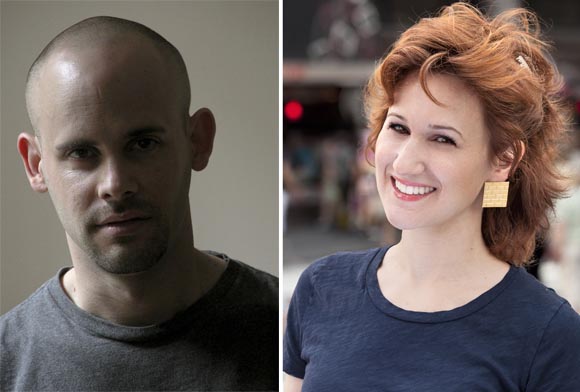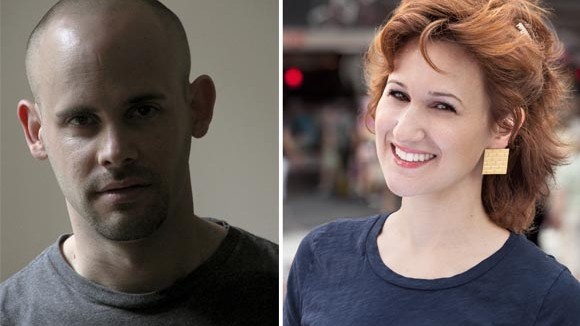

INTERVIEW: Carolyn and Andy London Are Eager to Please With Their New Project

Over the past decade,the husband-and-wife team Andy and Carolyn London have produced one of the most eclectic bodies of indie animated shorts in New York City. Working under the banner of London Squared, their films—Subway Salvation (2003), The Back Brace (2004), A Letter to Colleen (2007), The Lost Tribes of New York City (2009)—have a distinctive personal voice that is refreshingly unburdened by animation storytelling cliches. Their visual style has an earthy urban tone, and is a playground for stylistic exploration. They jump from style to style, and technique to technique, having made use of hand-drawn, stop-motion, pixilation, rotoscope, and After Effects.
I recently conducted an email interview with Andy and Carolyn. We talked about their history, their earlier short films, and the major new project that they’re developing: Eager to Please, an idea based on Andy’s family life that has already generated a graphic novel, interactive on-line comics, mini-shorts, as well as an offshoot TV series currently in development called Our Crappy Town.
Cartoon Brew: Your films are among the most stylistically diverse of any New York animators. Do you consciously attempt a different style with every film?
Carolyn and Andy London: We don’t consciously set out to do a different style, but in order to stay inspired and true to the story we want to tell, we almost always change mediums. A big part of what makes us happy as filmmakers is experimentation and being playful, but we usually let the story dictate the medium we work in. When we became obsessed with voices and the hilarious people you saw every day in the city, it led to our clay animated film Subway Salvation in 2003. When we were attempting to adapt an autobiographical “memory” story, it led us to create a ghostly, rotoscoped technique for A Letter To Colleen. When we need to tell the story of Andy and his scoliosis in a really demented comic way, it led to the cut-out physical object style of bagels, tuna cans and toilet paper tubes of The Backbrace. So who knows where it takes you.
Cartoon Brew: Do you think the constant experimentation has hurt you in any way or prevented you from broader recognition?
Carolyn and Andy: Sure, we’re confident that having a singular style is useful to getting the attention of a commercial rep or production company, but I guess we’ve been really undisciplined about that. It’s always been more interesting to us to keep growing, experimenting and developing our story telling skills. But oddly enough, two things have happened just by making films for the last 14 years.
1. We’ve gotten really good at storytelling and have started to create a world and recurring characters that are showing up in TV shows we’re developing and other series ideas.
2. The second thing that’s happened is we’re finally settling on a “signature look.” We’re starting to call it “THE MAGIC EYE.” Do you know those 2D image books where your eyes have to de-focus, and suddenly the 3D images come into the foreground? That’s the heart of what we do. Whether we’re finding faces in inanimate objects OR taking inanimate objects and abstracting them into characters, we’re using a Magic Eye technique and showing you characters that you didn’t know were there. It’s a kind of alchemy that we find endlessly entertaining and seems to be lending itself to a rich world. You can see examples of what we’re talking about in examples for the latest TED TALK we made and also the style frames for a series we’re developing called Our Crappy Town. This is the total example of ‘magic eye’.
Cartoon Brew: I think part of what makes your work so refreshing is that neither of you come from a traditional animation background. You had a lifetime of experiences before you made your first film. Tell me a little more about your backgrounds prior to becoming filmmakers. What attracted you to animation and made you choose it as an expressive outlet?
Andy: I majored in painting at Pratt in the Eighties. I worked as a guard at the Met and sold my work—mostly kinetic sex-related sculptures—at auctions at an East Village gallery called the Emerging Collector. Then I moved to Prague and wrote a graphic novel called Jeremy Pickle Goes to Prague that got published by Fantagraphics. It was there I learned to teach English as a Second Language, my trade for the next fifteen years. When I returned to New York with my future wife and collaborator Carolyn, I continued to teach ESL. First in illegal immigrant schools, then in tourist programs, then privately. Mostly Japanese bankers’ wives. Carolyn and I got a commission to do a music video in the late-Nineties and it was an excuse to dive into animation, which turned out to be a great fit.
Carolyn: I studied theater and playwriting at Brandeis University. I wasn’t exposed to a formal animation or film program, but I was exposed to set design, costume design, directing. A very early influence was growing up in Chicago. In the 80’s, they used to run the “Spike and Mike Animation Festival” at the Music Box Theater across the street from where my father lived. That was my early introduction to underground animation. And it was also the same time of Liquid Television on MTV. But all of the stuff I was watching on TV, my interest in writing and direction, plus my predilection for punk rock and new wave music shaped my sensibility. When I met Andy in the Czech Republic and he was doing comic books and graphic novels…it felt like a natural fit to bring our aesthetics and points of view together. It’s doing whatever you need to do to be in service of the story. And animation is a great way to make something. You can control all aspects of the product and use a wide range of elements to be infinitely expressive.
Cartoon Brew: One of your new projects, Eager to Please, is a step in a different direction yet again—it’s a graphic novel, an interactive on-line experience and a series of brief animated shorts called Made You Cringe. How do these all fit together, and what do you hope to accomplish with this expansive approach to narrative as opposed to the self-contained shorts you’ve produced in the past?
Carolyn and Andy: We want to create a world this time. A world that is the source material for a TV series. So a couple years ago, [Andy] decided to bite the bullet and write a graphic novel with a whole TV season’s worth of content. Then it came time to find a publisher and get it out there in the world. We soon quickly learned that there is limited interest in publishing graphic novels in the U.S. So this lead to rethinking the whole project. We put together a website called Eager-To-Please.com and began to explore various ideas. First was an interactive comic based on one of the stories from the book that did cool shit when you click and roll over things. Then we added an animated section called Made You Cringe based exclusively on the characters from the book. Those shorts gave us a chance to explore what an animated Eager To Please TV show would look like.
AND then we went to LA last year and started to work with a manager to help sell this idea. The funny (or not so funny part ) of this story is that we spent the last 8 months developing the look for the TV pitch, we have a 23-minute pilot episode, we created an animation test, bringing in graphics and packaging….and after all that work it seems like this series idea may be more successful as a live action idea. GOOD TIMES! But I guess this is normal in the development process. SO now we’re looking for the right producers to partner with and networks to pitch to. But in the meantime, we’d love to share our animation test online so everyone can see the development process.
Cartoon Brew: Eager to Please is intensely personal. In fact, one of the “stars” is Andy’s handicapped sister, which some readers might be uncomfortable with as a source of humor. It doesn’t seem that there’s anything in your personal life that you consider off-limits. Granted, Andy wrote it under a pen name, but do you ever feel you’ve gone too far afterward?
Andy: I don’t set out to humiliate my family. I love them. But there are stories that are crazy and poignant and funny and deep and I need to get them out in the world. Some of them are just straight up batshit. Some are heartbreaking. And I want to share this craziness with everybody because it’s so great. What parent do you know that makes twelve-foot tall barbecue pits out of Belgian blocks? Does anybody else have a 39-year-old sister whose spiritual guide is Mr. T? Maybe I shouldn’t write about how my parents had my sister arrested for sport but then I wouldn’t be doing the story justice or true to myself as a writer. My family is very unique, and think the world will appreciate every nutty detail.
Cartoon Brew: The first of the interactive Eager to Please shorts—”The Elephant Dollar”—is now on-line. Do you consider this more of an animated graphic novel or an interactive film? What do you think it’s possible to communicate with interactivity that you couldn’t through a traditional passive viewing experience?
Carolyn and Andy: It’s more of an animated graphic novel than an interactive film at this point. We want to go further with this idea. Perhaps with Andy’s follow up graphic novel entitled “I Give Up.” With iPad and smart phone technology, the possibilities are endless. We love printed books, however at the same time, we’re excited about all the new possibilities with web browsers, apps and e-readers. Film is beautiful but it’s not exactly interactive. And it seems like there should be a way to have a narrative experience that embraces the interactive technology of gaming– but still has the intimacy and pleasure of a graphic novel. We don’t know what this experience is just yet….it’s not a book and it’s not a game and it’s not a film…it’s something else and we’re challenging ourselves to figure out what that next thing is and how we can make it a cool, entertaining experience.
Cartoon Brew: Last year, one of your earlier films The Lost Tribes of New York City was featured in the high-concept “Talk to Me” exhibition at MoMA. How’d you manage to get your work into such a prestigious museum?
Carolyn and Andy: They found us! We had Lost Tribes running in various film festivals and online for approximately three years. Apparently they did a search and found our film and it fit into the theme of the show. It was pretty cool to be part of a show on technology, communication and design and see Lost Tribes in the context of other art projects other than film. It was also exciting to be part of a bigger dialogue about communication and technology and to get to contribute to this pool of ideas. We’ve always felt very inspired by established and contemporary art.
To learn more about their work, visit LondonSquared.net

.png)